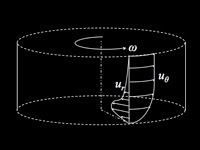Electrohydrodynamically-Induced Interfacial Vortex & Spiral Flows


In addition, it is also possible to use the surface vortices generated to trap microparticles, as depicted in the movie. The particles are drawn into the vortex streamlines due to positive dielectrophoresis and subsequently migrate towards the centre of the vortex due to shear gradients. This particle concentration mechanism is useful in biosensor technology due to the limitations of current biosensors to detect small amounts of pathogens.


-
1.DR Arifin, LY Yeo, JR Friend. Microfluidic Blood Plasma Separation Via Bulk Electrohydrodynamic Flows. Biomicrofluidics 1, 014103 (2007) (PDF).
-
2.LY Yeo, JR Friend, DR Arifin. Electric Tempest in a Teacup - The Tea Leaf Analogy to Microfluidic Blood Plasma Separation. Appl Phys Lett 89, 103516 (2006) (PDF).
-
3.LY Yeo, D Hou, S Maheshswari, H-C Chang. Electrohydrodynamic Surface Micro-Vortices for Mixing and Particle Trapping. Appl Phys Lett 88, 233512 (2006) (PDF).
-
4.JJ Qin, LY Yeo, JR Friend. MicroPIV and Micromixing Study of Corona Wind Induced Microcentrifugation Flows in a Cylindrical Cavity. Microfluid Nanofluid 8, 231-241 (2010) (PDF).
Press Releases:
-
1.If Research is Your Cup of Tea, this Eureka Moment will Stir the Blood, The Age, 16 August 2008.
-
2.Einstein's Tea Leaves Cause a Stir in Medical Circles, ABC Catalyst, Television Broadcast: 19 July 2007.
-
3.Stirring Things Apart, The Economist, 20 January 2007 (Print Version).
-
4.Einstein's Tea Leaves Inspire Gadget, Discovery Channel News, 19 January 2007.
-
5.Taking Blood Cells for a Spin, ScienceNOW, Science Magazine Daily News, 18 January 2007.
-
6.Einstein's Tea Leaves Inspire New Gadget, ABC Science Online, 17 January 2007.
-
7.Unique Blood Testing Method Developed, The Washington Times, 16 January 2007.

